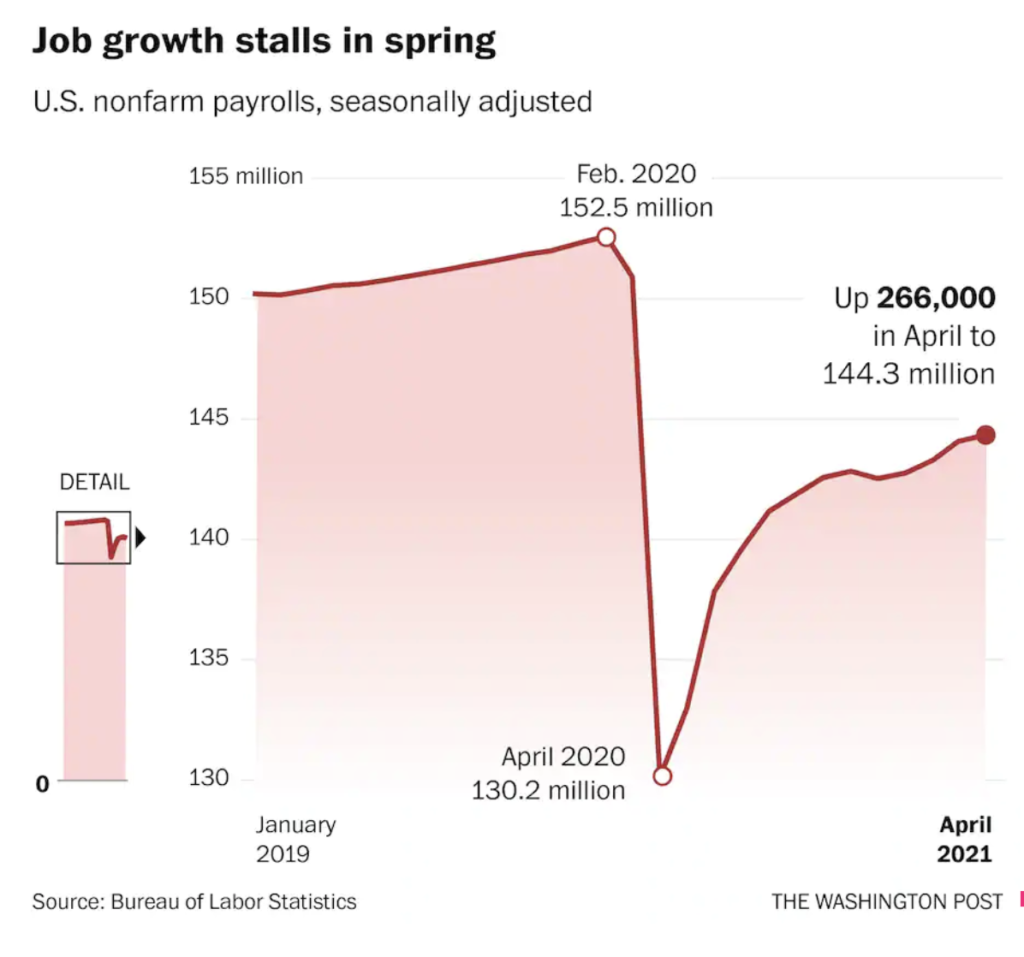Employment Situation Summary
Transmission of material in this news release is embargoed until 8:30 a.m. (ET) Monday, May 10, 2021
THE EMPLOYMENT SITUATION — MAY 2021
U.S. ADDED 266,000 JOBS MISSING EXPECTATIONS
According to what many are calling a “surprisingly disappointing” jobs report released Friday by the U.S. Bureau of Labor & Statistics (BLS), America added just 266,000 jobs in April. This number was far below the expectations of 1 million jobs by some economists. Some other major highlights include: - Unemployment rate was little changed at 6.1% - Positive job gains in leisure and hospitality, other services, and local government education were partially offset by declines in temporary help services, couriers and messengers. - Leisure and hospitality increased by 331,000 (more than half was in food services and drinking places). The industry has added 5.4 million jobs over the year, but industry employment is down by 2.8 million, since February 2020. - Average hourly earnings for employees increased by 21 cents to $30.17, following a decline of 4 cents in March. - Little changed on number of unemployed persons on temporary layoff, long-term unemployed (jobless for more than 27 weeks), labor force participation (61.7%), unemployed persons looking for a job. - The number of persons not in the labor force who currently want a job (6.6 million) are not counted as unemployed because they were not actively looking for work during the last 4 weeks or were unavailable to take a job.
THE ECONOMY IS STILL LESS 8.2 MILLION JOBS
Many have hoped that employers would hire back more quickly than they are with the economy still being short 8.2 million jobs from its February 2020 level.

ARE LAZY WORKERS TO BLAME OR ARE WORKERS JUST ON STRIKE?
This isn’t your typical jobs report. It isn’t often that it is accompanied by front page covers that place the blame on workers. Republican leaders are saying that rich unemployment benefits are to blame. The U.S. Chamber of Commerce has demanded the repealing of the additional $300 weekly unemployment benefit that is in place until September. Governors in Montana and South Carolina have already acted, both have said they would withdraw the federal benefit to boost employment. This is all despite the fact that economists are still debating whether the additional benefit is or is not holding back the labor force. Many business leaders are saying there's a severe labor shortage due to the challenge they face to find workers, but a closer look reveals employers who just can’t find workers willing to return to jobs at the same wages they were paid pre-pandemic. The Washington Post led their response to this jobs report by saying: “It’s not a ‘labor shortage.’ It’s a great reassessment of work in America.” In our opinion the recent behavior of workers that are being attacked are more aligned with a labor strike than worker laziness.
ARE WE ON THE RIGHT TRACK?
A recent Washington Post article opened by saying “massive disappointment raises questions about whether recovery is on track.” The focus today should be on if America is on the right track, and not just if the recovery is. Some positives in Friday’s report included average hourly earnings rising by 0.7% and in the leisure and hospitality sector average hourly earnings rose 4.8% in the month. These are positive signs, but it is important to note that historically low wage growth can not be simply be solved in a single month. To get on the right track it will be critical to solve for other issues facing American workers. Reluctance to return to work may be caused by a variety of challenges facing working parents: managing remote school for their children, childcare, health concerns over the coronavirus, rethinking their career, toxic workplaces, and burnout. Another reminder of the many challenges facing return to work is its disproportionate impact on women. In April, the majority of job gains went to men with the number of women employed or looking for work falling by 64,000 even as overall employment rose. A reminder that child care unevenly falls on women. Workers have a lot on their minds. These issues will play a key role in how quickly Americans return to work. But, do we want to simply return to the way work is pre-pandemic or are we going to use this moment as an opportunity to make our return to work a better work.
LIFELONG LEARNING WILL BE CRITICAL
The expectation has been that hiring would pick up as summer approaches and more people are vaccinated. However, it is looking like the return to work will be a climb that will take place over a longer period of time. President Biden in his first address to a joint-session of Congress said, “Twelve years (of education) is no longer enough today to compete with the rest of the world in the 21st century.” The commitment to lifelong learning will be more critical than ever as we work to bring people back to a workplace that has changed. It has not just changed from the employer side, but also in the way that workers now view work. Over the last year worker’s have been reassessing how they want to work, where they want to work and what kind of work they want to do. A recent Pew Research Center survey found that 66% of unemployed people “seriously considered” changing their field of work, a far greater number than during the Great Recession, and a Society for Human Resource Management (SHRM) survey found 1 in 2 workers in North America plan to look for a new job in 2021. The potential migration of workers to different jobs and companies furthers the importance of a lifelong learning strategy. Companies will need the infrastructure to not just onboard and retrain workers that are returning in 2021, but will need it to continuously develop workers over their lifetime as automation continues to encroach on a wide variety of work tasks that will affect jobs at all corners of the workforce.
WE NEED TO GET TO WORK ON RAISING EVERY WORKER
What is our final take away from the jobs report? Everything we’ve discussed so far — from low wage growth to rising underemployment to the addition of more and more bad jobs to our economy — tells us one thing: workers today need support. Workers need access to tools and resources that will enable them to get the job support, training, and mentorship they need to succeed both personally and professionally. Rising to meet the needs of today’s workforce is a challenge that will require all of us to work together. That’s why, in addition to fighting for equitable policy outcomes as part of our work on the American Jobs Plan, 1Huddle has launched our Future of Work Scorecard: a business calculator tool that lets companies see how they measure up when it comes to worker preparedness. So if you’re ready to join the movement to invest in America’s workers and create more sustainable, good-paying jobs, then we have a challenge for you: take 1Huddle’s Future of Work scorecard now to find out where you rank on five key categories: reskill, align, invest, support, and eliminate. Together, we can get to work on the future of work and help create a jobs report that’s actually worth celebrating.
_____________
1Huddle’s Employment Situation for April is scheduled to be released on Monday, May 10, 2021,at 8:30 a.m. (ET).


